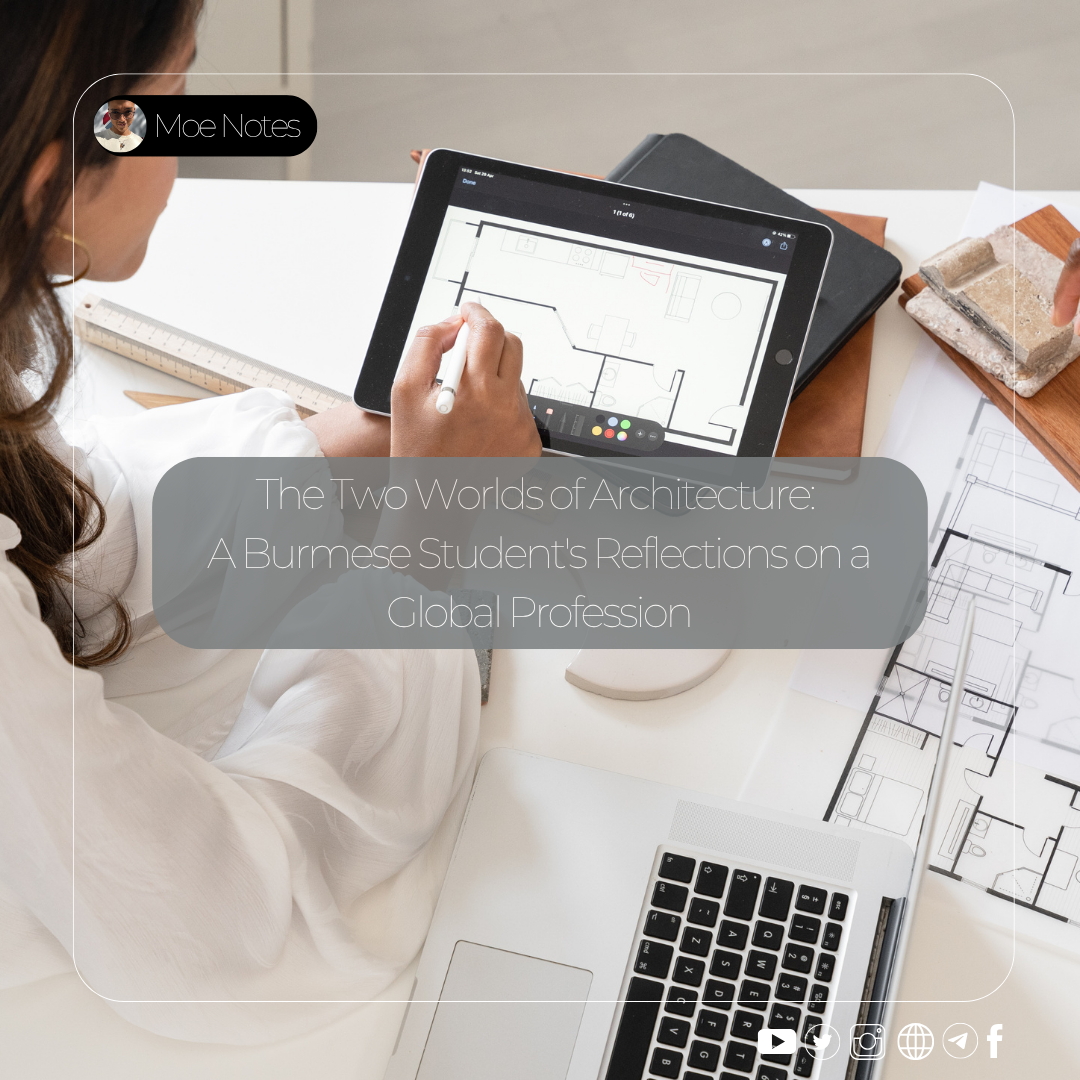The Two Worlds of Architecture: A Burmese Student's Reflections on a Global Profession

This article is also available in [Burmese]
Today’s post is less of an information-packed guide and more of a personal reflection, almost a diary entry. Why did I choose Architecture over so many other paths? How is this profession perceived differently across the world? And what is the reality of this journey?
This was one of the most difficult decisions of my life. I’ve touched on choosing a major before, but I want to dive deeper into the story of Architecture, sharing my perspective as someone standing with a foot in two very different worlds.
Part 1: A Tale of Two Systems - The Architect in Myanmar vs. The UK
The View from Home: A Valued Profession in a Devalued System
In Myanmar, we call it ဗိသုကာ (Bè-thoo-ka). It’s generally seen as a branch of engineering, a respectable field but certainly not a top-tier choice. It doesn't carry the same immediate prestige as becoming a doctor. In recent years, you see more 'Architecture Firms' or 'Studios' emerging, but there are no household names, no "celebrity architects" in the way there are renowned surgeons or physicians. The architect's role is to work in the trenches with civil engineers and site managers to bring a project to life.
From my perspective, the role of architecture in shaping modern Myanmar is smaller than it should be. This isn't a critique of my own major, but an observation on public perception and systemic priorities.
To be brutally honest, any field stagnates when professionals are governed by non-experts. I hear stories from my parents' generation about the unassailable prestige of institutions like the Rangoon Institute of Technology (RIT), before decades of decay set in. Now, we live in a different reality. It's an era where the brightest minds are suppressed, where sycophants are rewarded over the diligent, and where collaboration is seen as more suspicious than backstabbing. This corrosive environment exists everywhere, from small businesses to the highest levels of industry.
The result is a devastating brain drain. A talented professional in Myanmar might work for years only to earn a salary of 300,000-500,000 MMK per month. Who can build a future on that? When you know your effort won't be valued and your path for advancement is blocked, it is not a moral failing to stop trying so hard. As our experts leave the country or leave their fields, the quality of education declines. Fewer masters mean fewer capable students, which in turn means fewer future masters. It’s a vicious cycle that ends with us having to hire foreign firms to do the work our own people should be leading.
The simple truth is this: if our own people were empowered and valued, we wouldn't need to look elsewhere. My goal is to see a future where a young professional in Myanmar doesn't have to bow and scrape to every elder or authority figure just to get by. To fix this, we must start with education, a process that could take decades. But we must try. "ကိုယ်ဖွားသောမြေ ကိုယ့်မြေသည် အခြေတိုးမြင့်ကြံကောင်းသင့်တာကိုး။" (The land of one's birth, one's own land, deserves to be uplifted through striving.)
The View from Abroad: A Respected, High-Stakes Profession
Here in the UK, the reaction is completely different. When you tell someone you study architecture, their response is often, "Wow."
That "wow" is a recognition of the profession's immense difficulty and prestige. Architecture is understood to be a high-pressure, intellectually demanding field with enormous responsibility. This reputation is backed by facts:
- High Entry Barriers: Universities demand top grades. While another course might ask for A-level grades of BBB, a competitive architecture programme will often require A*AA. Beyond grades, a compelling and creative portfolio is non-negotiable.
- Intensive and Expensive Education: This isn't a degree you can complete with just a laptop. It requires a vast array of tools, equipment, software, and materials for model-making, driving up costs significantly.
- High Professional Standards & Salary: Architecture is a protected title in the UK. You can't call yourself an architect without being registered with the Architects Registration Board (ARB). This regulation upholds standards and contributes to higher earning potential. According to the UK's National Careers Service, experienced architects can earn between £45,000 and £70,000+ per year, placing it well above the national average salary.
While it may not be a rapidly "growing" field like computer science, it is a deeply established and respected profession with a stable demand. It’s a career that works.
Part 2: The Architect's Path - A Blueprint for Aspiring Students
For any Burmese student considering this path, understanding the structure of the journey is critical.
The Qualification Pathway in the UK
Becoming a registered architect in the UK is a three-part journey, typically taking at least seven years. This is a crucial piece of information that is often overlooked. The process is overseen by the Royal Institute of British Architects (RIBA):
- RIBA Part 1: This is your undergraduate degree, usually a 3-year BA or BSc in Architecture. This is the stage I am currently at.
- Year of Practical Experience: After Part 1, you are required to work in an architectural practice for at least a year.
- RIBA Part 2: This is a 2-year postgraduate degree, like a Master of Architecture (M.Arch).
- Further Practical Experience: Another year of recorded professional experience is required after Part 2.
- RIBA Part 3: This is the final professional examination, which includes a written exam, a case study, and a professional interview.
Only after successfully completing all three parts can you register with the ARB and officially call yourself an architect.
Strategic Decision: UK vs. Canada
When I was applying, my final two choices were the UK and Canada.
- Canada: The degree programmes were typically four years long, entry requirements felt even higher, and the top universities were more expensive than their UK counterparts of a similar global ranking.
- UK: The pathway started with a three-year degree, the country is renowned for architectural education (with many top-ranked schools), and the overall cost and time commitment felt more manageable.
For me, the UK was the clear strategic choice.
My Experience at Oxford Brookes
I chose Oxford Brookes specifically. I’ve never been a fan of the intense, overwhelming "city style" of places like Toronto. Oxford offered a rich academic environment without the chaos of a megacity. For me, university wasn't just about attending classes; it was about hitting "reboot" on my life in a new environment, with a new mindset. That feeling of a fresh start was invaluable.
The School of Architecture at Oxford Brookes is highly regarded and has a strong reputation. A huge advantage is our proximity to London. It's easy to get there any time, day or night, with tickets starting around £25. This access is essential. On a recent field trip, we studied the incredible structures around Waterloo Station. Afterwards, I even found a small Burmese restaurant nearby—I think it was called "Lahpet." To be honest, the food was too adapted for the British palate for my liking, but the experience was part of the journey.
Part 3: A Personal Reflection - Passion, Pragmatism, and Purpose
I need to confess something. I don't "love" architecture.
When I was choosing my major, I was terrified of purely academic subjects. My passions were in the arts—filmmaking, photography, writing. Those felt like nirvana, but a difficult path to a stable career. Architecture seemed like the perfect compromise: a design-related field, creative, but with a clear professional structure. I didn't even know about the endless hours of model-making and technical drawing when I first chose it.
So, I find myself in a major that I respect immensely but don't feel a burning passion for. But I've made my decision, and my guiding principle now is that wherever I am, I must strive to be the best I can be. With that mindset, I find myself becoming engaged, even invested.
This doesn't mean I've abandoned my other passions. They are what keep me whole. This summer, I plan to shoot videos and create photographs. I am the kind of person who dives deep into anything that catches my interest. This made choosing one major difficult, but it also means I have a multidisciplinary toolkit. My "Moe Notes" hub is the perfect expression of this—a place where architecture, film, photography, and writing can all coexist.
I chose my path, and I don't believe it was a mistake.
Let me end this long reflection here. We all just do our best to get through it, don't we?
My task for you today is simple.
- Reflect on a path you have chosen—be it a school, a job, or a major. Why did you choose it? What has it taught you about the world, and about yourself?



